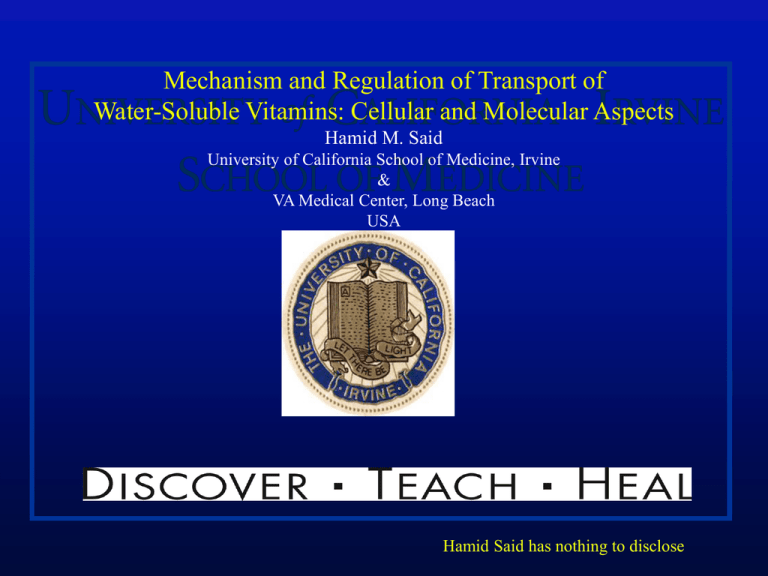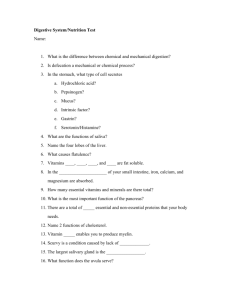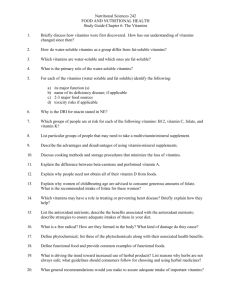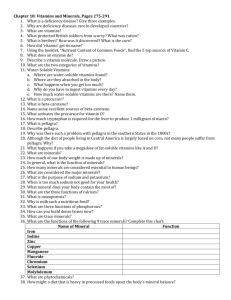Mechanism and Regulation of Transport of Hamid M. Said
advertisement

Mechanism and Regulation of Transport of Water-Soluble Vitamins: Cellular and Molecular Aspects Hamid M. Said University of California School of Medicine, Irvine & VA Medical Center, Long Beach USA Hamid Said has nothing to disclose THANK YOU! Acknowledgements Current and Previous Postdocs P Srinivasan, PhD W Tipton, MD A Ghosal, PhD S Khorchid, MD A Biswas, PhD D Dunning, MD S Senthilkumar, PhD D Dyer, PhD S Subramanya, PhD E McCloud, MD T Sekar, PhD K Balamurugan, PhD F Bukhari, MD J Redling, PhD L Vogeley, MD V Subramanian, PhD L Mee, PhD C Kumar, PhD Z Mohammed, MD N Chatterjee, PhD A Balasubramanien, PhD R Ul-Haq, MD S Nabokina, PhD T Nguyen, PhD ”We thank the NIH and the DVA for their kind support” THANK YOU! Acknowledgements Collaborators W Strum (Scripps) D Hollander (UCI) C Wagner (Vanderbilt) D Horne (Vanderbilt) F Ghishan (Vanderbilt) I Parker (UCI) J Marchant (U Minn) T Ma (UNM) P Dudeja (UIC) N Vaziri (UCI) N Yanagawa UCLA) C Halsted (UCD) J Sze (Albert Einstein U) K Maedler (U Bremen) G Hecht (UIC) V Subramanian (UCI) S Pandol (UCLA) H Tsukamoto (USC) ”We thank the NIH and the DVA for their kind support” Molecular/C ellular Biology Nutrition Mechanism of Disease Physiology of Vitamin Transport Microbiology Toxicology/ Pharmacolog y *Water – Soluble Vitamins: An Introduction* 1) Water-soluble vitamins are structurally and functionally unrelated organic compounds that share the common features of being essential for normal cellular function, growth and development. O O H O O Cl N N N Pyridoxin e N N O N H H HOO C N O Biotin Folic acid O N OH H N HOOC H O N O O S O N H N OH O H 3C N CH 3 O Cl N N O O N O N O S N N O Pantothenic acid Riboflavi n Thiamin O O O O O O O N O Ascorbic Acid Niacin *Water-soluble vitamins: An introduction* -----continues 2) Humans cannot synthesize water-soluble vitamins (exception: some endogenous synthesis of niacin), and thus, must obtain these micronutrients from exogenous sources. 3) Deficiency of water-soluble vitamins leads to a variety of clinical abnormalities that range from anemia, growth retardation, congenital deformities, and neurological disorders. -Vitamin deficiency is of two types: i) Systemic (global) deficiency ii) Tissue-specific (localized) deficiency (e. g., ThiaminResponsive Megaloblastic Anemia) 4) Optimizing body homeostasis of water-soluble vitamins, on the other hand, brings about positive health benefits *Folate: -Prevention of neural-tube defects -Decrease risk of Alzheimer Disease -Decrease risk of the development of certain types of cancer (e.g. cervical cancer) *Thiamin: -Has the potential of preventing diabeticretinopathy, nephropathy, and vascular damage Why study transport of water-soluble vitamins? The case for the intestine The case for the intestine---continues 1) The human body cannot synthesize these micronutrients nor can it store them in significant quantities; it relies on uninterrupted absorption in the gut. 2) Water-soluble vitamins exist in minute quantities in the diet, and thus, efficient mechanisms are needed for their extraction from the moving food digest in gut lumen. 3) A variety of conditions interfere with normal intestinal absorption of water-soluble vitamins. Examples of the conditions that are associated with impairment in intestinal absorption of water-soluble vitamins • Congenital defect in the specific uptake system (e.g., mutations in PCFT leading to Hereditary Folate Malabsorption Syndrome) • Congenital defects in the enzyme that hydrolyzes non-absorbable dietary forms of the vitamin into the absorbable form (e.g., Biotinidase - deficiency) • Chronic alcohol consumption • Bacterial infection (enteropathogenic E. coli, EPEC) • Drug-interaction • G.I. diseases (e.g., IBD); intestinal resection Why study transport of water-soluble vitamins? The case for the intestine----continues 4) Optimization of water-soluble vitamin bioavailability and body homeostasis via optimized absorption improves health and prevents certain diseases. Sources of water- soluble vitamins Two sources are available to the human gut: 1) Dietary 2) Bacterial (i. e., the normal microflora of the large intestine) Sources of water- soluble vitamins----dietary source - This is where we were in the early 1980s -Early studies on the mechanisms involved in the intestinal absorption of (many) water-soluble vitamins have concluded that these events occur via simple diffusion. -This came out as a result of the use of non-physiological/non-optimal experimental conditions. Further, when evidence for the existence of a specific mechanism was observed, e. g., saturability, it was attributed to intracellular metabolism, limited solubility of the vitamin (due to existence of an acidic microclimate at the surface of the small intestine), etc. -The above erroneous belief has significantly delayed progress in the field. Thus, very limited studies were attempted to investigate if and how these absorptive events are regulated, whether they are affected by certain disease conditions or by drug interaction, and whether certain human genetic diseases are due to defects in vitamin transporters. This is where we are in 2012 Involvement of specific, carrier-mediated and highly regulated transport systems in the absorption of dietary water-soluble vitamins in the human small intestine Lumen Ascorbic Acid Riboflavin Pyridoxine Thiamine Biotin/ Pantothanate Folate THTR2 SVCT 1 SVCT 2 Blood RFT2 RFT1 ?? THTR1 THTR-1 SMVT ?? PCFT MDR-3 Niacin Sources of water- soluble vitamins----dietary source Absorption of certain dietary water-soluble vitamins in the small intestine is sitespecific; However adaptation (induction) occur following resection Sham-operated Resected Am J Clin Nutr 47:75-9, 1988 Sources of water- soluble vitamins 1) Dietary source 1) Bacterial source, i. e., the normal microflora of the large intestine. Humans have more bacteria in their GI tract than they have cells Human Body 1012 Cells 1014 Bacteria GI Tract * There are over 1,800 different species of bacteria in our GI tract identified so far. Microbial distribution in the GI tract Aerobes Stomach Small Intestine Duodenum <102 cfu/mL pH, 1-2 101-3 cfu/mL pH, 6-7 Jejunum 103-4 cfu/mL pH, 6-7 Ileum 107-9 cfu/mL pH, 6-7 Colon <1010-12 cfu/mL pH, 5-7 Anaerobes According to Mayo Clin Proc 2008; 83:460-469 Happy VS unhappy intestinal microflora vitamin vitamin Adopted from Gastroenterology 2009;136:2015-2031 -Bacterial source-----continues Enterotypes of the human gut microbiome Arumugam et al, Nature 473:174-180, May 2011 *Human microbiota can be functionally classified into three distinct enterotypes: -Enterotype A: Has an over-represented Biotin (vitamin B7; vitamin H) biosynthetic pathway -Enterotype B: Has an over-represented Thiamin (vitamin B1) biosynthetic pathway -Enterotype C: Has an over-represented Haem biosynthetic pathway Functional differences between enterotypes (Nature 473:174-80, 2011) a. b. c. Four enzymes in the biotin biosynthesis pathway are overrepresented in enterotype 1. Four enzymes in thiamine biosynthesis pathway are overrepresented enterotype 2. Six enzymes in the haem biosynthesis pathway are overrepresented in enterotype 3. Arumugam M, Raes J, Pelletier E, Ehrlich DS , Bork P et. al. “Enterotypes of the human nature in microbiome.” Nature. 2011 A473(7346):174-80pr 20. Doi: 10.1038. Science Bacteria Divide People Into 3 Types, Scientists Say By Carl Zimmer Published: April 20, 2011 “The ability of the microbiota to synthesize vitamins has been known for many years, but this was considered unimportant for nutritional health, because it was assumed they were malabsorbed and lost in stools. However, the recent demonstration of specific transporters for folate (24), biotin (25), thiamine (26), riboflavin (27), and pyridoxine (28) in the colonic mucosa has forced us to reconsider our view.” O”Keefe et al, J. Nutr. 139: 2044-2048, 2009 Identification of carrier-mediated transport systems for water-soluble vitamins in the human colon Studies with colonic tissue from human organ donors and with cultured colonocytes Lumen Niacin Riboflavin Pyridoxine Thiamine Biotin/ Pantothanic acid Folate THTR2 ?? RFT2 ?? THTR1 SMVT RFC TPP RFT1 THTR-1 MDR-3 Blood Said et al 1995- present Implications for the identification of efficient mechanisms for absorption of water-soluble vitamins in the human colon are: 1) They indicate that the bacterially synthesized vitamins are nutritionally available to the host and contribute toward overall vitamin homeostasis, especially toward the cellular nutrition and health of the local colonocytes. 2) Provides physiological basis for important nutritional and clinical observations. Intestinal absorption of water-soluble vitamins I. 1) Physiological aspects Studies using a variety of intestinal preparations (intact tissue in vitro and in vivo, purified isolated brush border and basolateral membrane vesicles, cultured intestinal epithelial cell models) have shown that the trans-epithelial and the trans-membrane transport events of water-soluble vitamins are all specific and carriermediated in nature. 2. Energetics of intestinal transport processes of water-soluble vitamins: i) The case for biotin Na+ Na+ Biotin-Biotin hSMV T Brush Border Membrane Biotin- Basolateral Membrane 2. Energetics of intestinal transport processes of water-soluble vitamins: ii) The case with folate H+ H+ Folate-Folate PCFT Brush Border Membrane Folate- Basolateral Membrane II. Molecular aspects 1) Molecular identity of many of the transporters of water-soluble vitamins have been determined by cloning. Predicted topology of hTHTR-1 Asn63 Ser49 Ser186 1 2 3 4 5 Asn314 6 7 Ser292 Thr22 Thr158 NH2 Ser222 Thr223 Asn414 8 129 10 11 12 Ser357 Thr360 Thr477 COOH Thr17 Cytosol PKC phosphorylation sites PKA phosphorylation site N-glycosylation sites 2. The 5’ regulatory region (promoters) of a number of the genes that encode transporters of water-soluble vitamins have also been cloned and characterized both in vitro and in vivo. SLC19A2 (hTHTR-1)-Promoter SLC19A3 (hTHTR-2)-Promoter Luciferase Luciferase Reidling and Said, AJP, 285:C633-41, 2003 Nabokina and Said, AJP 287:G822-9, 2004 . In vivo validation of promoter activity in transgenic mice. SLC19A2 Promoter SLC19A3 Promoter Luciferase Luciferase In vivo validation of promoter activity of the C. elegans folate transporter cfolt1 (fused to GFP) at the integrative whole animal level AJP 293:C670-681, 2007 - 3) Relative contribution of water-soluble vitamin transporters toward carrier-mediated uptake processes i) Gene-specific knock down ii) Gene-specific knockout i) Gene-specific knock down (siRNA) Relative contributions of hTHTR-1 and hTHTR-2 toward carrier-mediated thiamin uptake by human intestinal epithelial Caco-2 cells 0.06 0.04 0.03 0.02 0.01 Scrambled siRNA hTHTR-1 + hTHTR-2 siRNA hTHTR-2 siRNA hTHTR-1 0 Control Carrier-mediated 3H-Thiamine Uptake (pmol/mg protein/3 min) 0.05 AJP 286:G491-G498, 2003 ii) Gene-specific knockout: the mouse model Intestinal thiamin absorption in THTR-2 KO mouse model: In vivo perfusion P < 0.01 Gastroenterology 138:1802-1809, 2010 Intestinal thiamin absorption in THTR-1 KO mouse model: In vivo perfusion Relative expression of THTR-2 in THTR-1-/- mouse intestine 500 Wt THTR-1 -/- THTR-2 400 _ -actin 300 200 100 0 Wt THTR-1 -/- II. Cell Biology Aspects 1) Live cell confocal imaging showed expression of hTHTR-1 at both the apical and basolateral membrane domains (A, B), while that of hTHTR-2 (C, D) only at the apical membrane domain of polarized human epithelial cells. JBC 278:3976-84, 2003; JBC 281:5233-45, 2006 2. Targeting of water-soluble vitamin transporters to the apical membrane domain of polarized intestinal/renal epithelia involves specific motifs (signals) that are embodied in the individual polypeptide: The story with the human folate transporter, PCFT. AJP 294:C233-240, 2008 3. A predicted β-turn motif between TMD 2 and 3 of PCFT was found using a β-Turn Predictive Algorithm Program: Progressive mutagenesis of amino acids within this region is predicted to disrupt formation of the β-turn. A xz xy hPCFT-YFP hPCFT[GRR112114AAA]-YFP 3H-Folic acid uptake(pmol/mg protein/3min) 4. Disrupting the β-turn between TMD 2 and 3 of the PCFT polypeptide leads to: A) intracellular retention of the mutant protein in polarized epithelial cells, and 3) inhibition in the induction of folate uptake. 0.8 B 0.6 0.4 0.2 0 Control hPCFT-YFP hPCFT[GRR112114AAA]-YFP 5. Different mutants of hTHTR-1 found in patients with TRMA display different cellular expression phenotypes. a Clin Sci (Lond). 113: 93-102, 2007 6. Intracellular movement of hTHTR -1 & 2 (fused to GFP) in living human epithelial cells involves trafficking vesicles (A), whose movement depends on an intact microtubule network (B). A. Control B. Nocodazol JBC 278:3976-84, 2003; JBC 281:5233-45, 2006 7. Specific accessory proteins interact with membrane transporters of watersoluble vitamins and modulate their function, stability, and membrane expression: Studies using bacterial and yeast two-hybrid system to screen human intestinal cDNA libraries. hTHTR1 hSMVT hRFC Tspan1 PDZD11 AJP 301:G808-13, 2011 AJP 300:G561-7, 2010 Dynein light chain road block AJP 297:G480-7, 2009 III. Regulatory aspects of the intestinal absorption processes of water-soluble vitamins A) Adaptive - regulation by dietary (extracellular) substrate levels. B) Developmental - regulation during early stages of life. C) Differentiation - dependent regulation. D) Regulation by specific intracellular protein kinase-mediated pathways. Adaptive - regulation of the intestinal biotin absorption process 1) Dietary-induced biotin deficiency in rats leads to a specific induction in intestinal biotin uptake, while dietary over-supplementation of biotin leads to suppression of the uptake. Vmax (pmol/mg protein/20 sec) Apparent Km (µM) Control 2.2 14.5 Biotin - Deficiency 5.4 11.1 Biotin - Over Supplementation (X100) 1.1 14.0 Condition AJP 256:G306-311, 1989 2) Similarly, maintaining the human-derived intestinal epithelial Caco-2 and HuTu-80 cells under biotin-deficient conditions leads to a specific induction in biotin uptake and in the level of expression of the hSMVT protein and mRNA. *p < 0.01 AJP 292:G275-281, 2007 3) The effect of biotin deficiency on biotin uptake by Caco-2 and HuTu80 cells was not mediated via changes in mRNA stability of hSMVT. RNA decay rate assay (i.e., RNA stability assay) 4) The induction in hSMVT mRNA levels in Caco-2 and HuTu-80 cells in biotin deficiency is mediated, at least in part, via transcriptional mechanism(s). hSMVT (SLC5A6)- promoter Luciferase *p < 0.01 5) The biotin-deficiency responsive region of the hSMVT P1 is located in a specific (103 bp) region between -130 and -233 6) A KLF4 cis-regulatory element in the biotin deficiency-responsive region of the hSMVT P1 is responsible for mediating the biotin deficiency effect on the hSMVT promoter. Integrative aspects of the adaptive - regulation of vitamin transport by substrate level: Whole animal studies utilizing living C. elegans 1) Folate over-supplementation inhibits folate uptake (A), as well as the level of expression of the cfolt-1 mRNA (B) in adult C. elegans 1.0 0.5 0 *p < 0.01 for both B Relativefolt-1 mRNA expression overb-actin (in folds) [3H] -folic acid uptake (fmol/5 animals/5 min) A 2 1 0 AJP 293:C670-681, 2007 2) Folate over-supplementation suppresses the activity of the cfolt-1 promoter (fused to GFP) in living C. elegans. Over-supplemented Level of GFP fluorescence in the C. elegans intestine GFP fluorescence intensity (%) Deficient 100 50 0 (p < 0.01) Developmental - regulation of intestinal and renal thiamin uptake process 1. Carrier-mediated uptake of [3H]-Thiamine by mouse intestinal BBMV during development was found to decrease with maturation (suckling > weanling > adult). 2. A decrease in levels of the mouse endogenous mTHTR-1 and mTHTR-2 protein and mRNA (suckling > weanling > adult) was observed in the intestine during developmental maturtion using Western analysis and qPCR 3. Luciferase activity in the intestine of transgenic mice carrying the human SLC19A2 or SLC19A3 promoters showed a decrease in activity with maturation (suckling > weanling > adult). 4. Carrier-mediated uptake of [3H]-thiamine by mouse kidney BBMV during development was found to decrease with maturation (suckling > weanling > adult). 5. A decrease in levels of the mouse endogenous mTHTR-1 and mTHTR-2 protein and mRNA (suckling > weanling > adult) was observed in the kidney during developmental maturation using Western analysis and qPCR 6. Luciferase activity in the kidney of transgenic mice carrying the human SLC19A2 or SLC19A3 promoters showed a decrease in activity with maturation (suckling > weanling > adult). IV. Mechanism of Disease A) Effect of chronic alcohol use on intestinal (and renal) absorption of water-soluble vitamins. A) Effect of Enteropathogenic Escherichia coli (EPEC) on intestinal absorption of water-soluble vitamins. A) Thiamin-Responsive Megaloblastic Anemia (TRMA): -Why only certain tissues are affected? -How mutations in hTHTR-1 in patients with TRMA impair thiamin uptake. Mechanism of Disease-----continues Effect of chronic alcohol feeding/exposure on cellular and molecular parameters of the intestinal (and renal) thiamin absorption process - Thiamin deficiency and sub-optimal levels are highly prevalent in chronic alcoholics (up to 75%) and leads to serious clinical consequences (e.g., Wernicke-Korsakoff syndrome). - We examined the physiological and molecular parameters of the intestinal (and renal) thiamin absorption process that are affected by chronic alcohol consumption. 1. Chronic alcohol feeding of rats leads to a significant inhibition in thiamin uptake by jejunal BBMV. *p < 0.01 for all AJP 299:G23-31, 2010 2. Chronic alcohol feeding of rats also leads to a significant inhibition in thiamin uptake by jejunal BLMV. *p < 0.01 3. Chronic alcohol feeding of rats also inhibits thiamin uptake in the colon, suggesting possible impairment in uptake of the bacterially synthesized biotin. *p < 0.01 4. Chronic alcohol feeding of rats inhibits the expression of THTR-1 (but not THTR-2) protein at the intestinal BBM. *p < 0.01 5. Chronic alcohol feeding of rats inhibits mRNA expression of THTR-1 (but not THTR-2) in the jejunum. *p < 0.01 7. Chronic alcohol exposure (72 hr) of cultured human-derived intestinal epithelial HuTu-80 cells leads to significant inhibition in thiamin uptake. *p < 0.01 8. Chronic alcohol exposure (72 hr) of HuTu-80 cells leads to a significant inhibition in the level of expression of the hTHTR-1 and hTHTR-2 proteins. *p < 0.01 for both 9. Chronic alcohol exposure (72 hr) of HuTu-80 cells also leads to significant inhibition in the expression of the hTHTR-1 and hTHTR-2 mRNA. *p < 0.01 for both 10. Effect of chronic alcohol exposure (72 hr) of human intestinal epithelial HuTu-80 cells on the activity of hTHTR-1 (SLC19A2) and hTHTR-2 (SLC19A3) promoters. hTHTR-1 (SLC19A2)-Promoter) *p < 0.01 for both Luciferase hTHTR-2 (SLC19A3)-Promoter) Luciferase 11. Chronic alcohol feeding of transgenic mice carrying the SLC19A2 (hTHTR1)- and SLC19A3 (hTHTR-2)- promoters leads to a significant inhibition in activity of the human promoters in the jejunum. SLC19A2 Promoter Luciferase SLC19A2 Promoter 120 Relative Luciferase activity 120 Relative luciferase activity Luciferase 100 80 60 40 20 100 80 60 40 20 0 0 Control (Pair-fed) *p < 0.01 for both Alcohol Control (Pair-fed) Alcohol Effect of chronic alcohol feeding on physiological and molecular parameters of renal thiamin transport 1) Effect on [3H]thiamin uptake by rat renal BBMV 2) Effect of chronic alcohol feeding on [3H]thiamin uptake by rat renal BLMV 3) Effect of chronic alcohol feeding on level of expression of THTR1 and THTR-2 in kidney cortex of rats fed alcohol chronically 4) Effect of chronic alcohol feeding of rats on level of expression of heterogeneous nuclear RNA (hnRNA) of the Slc19a2 & Slc19a3 genes 5) Chronic alcohol feeding of transgenic mice carrying the SLC19A2 and SLC19A3 promoters leads to a significant inhibition in activity of the human promoters in the renal cortex. SLC19A2 Promoter SLC19A2 Promoter Luciferase 120 _ 60 * 0 Control (Pair-fed) * p < 0.01 Relative SLC19A3 luciferase activity (% of control) Relative SLC19A2 luciferase activity (% of control) 120 Luciferase 60 * 0 Alcohol Control (Pair-fed) Alcohol Effect of Enteropathogenic Escherichia coli (EPEC) infection and intestinal thiamin uptake 1) EPEC, a gram-negative food-borne pathogen, infects human intestine leading to significant morbidity and mortality, especially in infants. Infection with EPEC is common in developing countries; it also occurs in developed countries as a result of food contamination and improper hygiene. 2) Whereas diarrhea is a major consequence of EPEC infection, malnutrition also occurs especially in severe and prolonged cases. 3) Pathogenicity of EPEC involves attachment of the bacteria to enterocytes, effacement in the microvilli, and delivery of effector molecules via a syringe-like type III secretion system (TTSS). 4) Nothing is known about the effect of EPEC infection on intestinal absorption of thiamin. Addressing this issue of physiological and nutritional importance since humans have limited capability to store thiamin, and thus, prolonged and severe infection with EPEC may negatively impact normal body homeostasis leading to further aggravation of the health status of the infected hosts (many of whom are already nutritionally compromised). Results 1) EPEC treatment of Caco-2 cells leads to a significant inhibition in thiamine uptake. Uptake was performed immediately after treatment (A) or 6 hr later (B). A *p < 0.01 for both B AJP 297: G825-833. 2009 2) The inhibition in thiamin uptake by Caco-2 cells caused by EPEC (100 MOI) increases as a function of the pretreatment (contact) time. 3) The inhibition in thiamin uptake by Caco-2 cells requires live EPEC. *p < 0.01 4) EPEC inhibits thiamin uptake at both the nanomolar range (mediated by hTHTR-2) and the micromolar range (mediated by hTHTR-1). 5) EPEC reduces the level of expression of the hTHTR-1 and hTHTR-2 proteins at the apical membrane domain of confluent Caco-2 monolayers. *p < 0.01 for both Biotinylation assay 6) EPEC inhibits the level of mRNA expression of hTHTR-1 (A), and hTHTR-2 (B). A *p < 0.01 for both B 7) EPEC, but not the non pathogenic E. coli, suppresses the activity of the human SLC19A2 and SLC19A3 promoters in Caco-2 cells. *p < 0.01 for both 8) Functional type III secretion system (TTSS) of EPEC is required for the bacteria to inhibit thiamin uptake by Caco-2 cells. *p < 0.01 “Few Take Home Messages” 1) Absorption of dietary water-soluble vitamins in the small intestine involves specific, and regulated carrier-mediated systems. 2) The water-soluble vitamins synthesized by the normal microflora of the large intestine can be absorbed via efficient carrier-mediated systems, and thus, contribute to the overall body homeostasis of these micronutrients, and especially toward the cellular nutrition and health of the local colonocytes. 3) A variety of conditions/factors interfere with the intestinal absorption of water-soluble vitamins; this may lead to a compromise in their normal body homeostasis. Thank you



